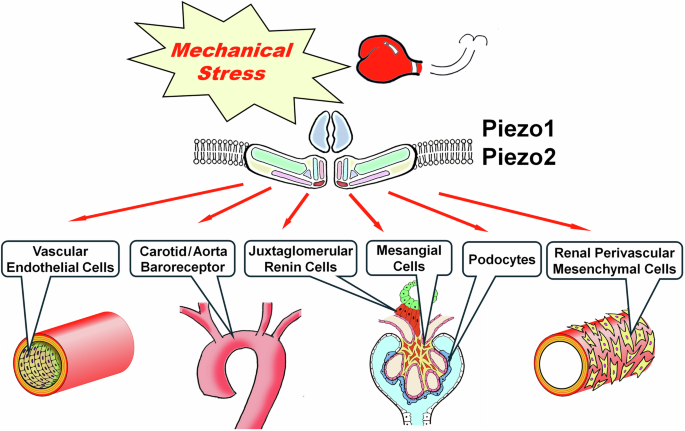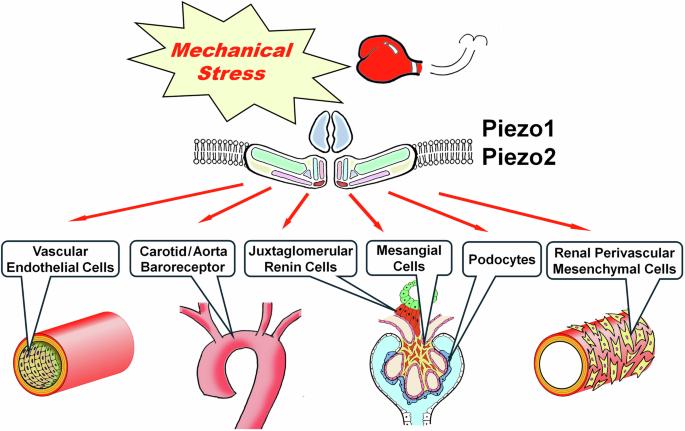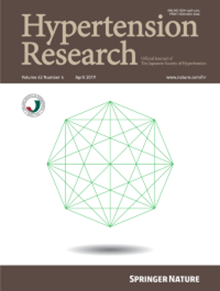压电离子通道:寻找已久的介导高血压和高血压肾病的机械传感器。
IF 4.3
2区 医学
Q1 PERIPHERAL VASCULAR DISEASE
引用次数: 0
摘要
机械生物学的最新进展和机械敏感离子通道的发现为高血压及相关疾病的研究开辟了新纪元。2010 年首次报道的 Piezo1 和 Piezo2 被认为是真正的机械通道,在多个组织和器官中介导各种生物和病理生理现象。例如,Piezo 通道在血压控制、触发剪切应力诱导的一氧化氮合成和血管扩张、调节颈动脉窦和主动脉的气压反射以及从肾脏并肾小球细胞释放肾素等方面起着关键作用。在此,我们概述了最近关于压电离子通道在高血压发病机制和相关肾脏损伤中的作用的文献,包括我们关于压电离子通道 1 参与荚膜细胞损伤以及压电离子通道 2 参与高血压肾病动物模型中肾素表达和肾脏纤维化的实验数据。机械敏感性离子通道 Piezo1 和 Piezo2 通过作用于血管内皮细胞、颈动脉和主动脉的气压感受器以及并肾小球装置,在全身性高血压的发病机制中发挥着各种作用。压电通道还通过作用于间质细胞、荚膜细胞和血管周围间充质细胞,导致高血压肾病。本文章由计算机程序翻译,如有差异,请以英文原文为准。


Piezo ion channels: long-sought-after mechanosensors mediating hypertension and hypertensive nephropathy
Recent advances in mechanobiology and the discovery of mechanosensitive ion channels have opened a new era of research on hypertension and related diseases. Piezo1 and Piezo2, first reported in 2010, are regarded as bona fide mechanochannels that mediate various biological and pathophysiological phenomena in multiple tissues and organs. For example, Piezo channels have pivotal roles in blood pressure control, triggering shear stress-induced nitric oxide synthesis and vasodilation, regulating baroreflex in the carotid sinus and aorta, and releasing renin from renal juxtaglomerular cells. Herein, we provide an overview of recent literature on the roles of Piezo channels in the pathogenesis of hypertension and related kidney damage, including our experimental data on the involvement of Piezo1 in podocyte injury and that of Piezo2 in renin expression and renal fibrosis in animal models of hypertensive nephropathy. The mechanosensitive ion channels Piezo1 and Piezo2 play various roles in the pathogenesis of systemic hypertension by acting on vascular endothelial cells, baroreceptors in the carotid artery and aorta, and the juxtaglomerular apparatus. Piezo channels also contribute to hypertensive nephropathy by acting on mesangial cells, podocytes, and perivascular mesenchymal cells.
求助全文
通过发布文献求助,成功后即可免费获取论文全文。
去求助
来源期刊

Hypertension Research
医学-外周血管病
CiteScore
7.40
自引率
16.70%
发文量
249
审稿时长
3-8 weeks
期刊介绍:
Hypertension Research is the official publication of the Japanese Society of Hypertension. The journal publishes papers reporting original clinical and experimental research that contribute to the advancement of knowledge in the field of hypertension and related cardiovascular diseases. The journal publishes Review Articles, Articles, Correspondence and Comments.
 求助内容:
求助内容: 应助结果提醒方式:
应助结果提醒方式:


